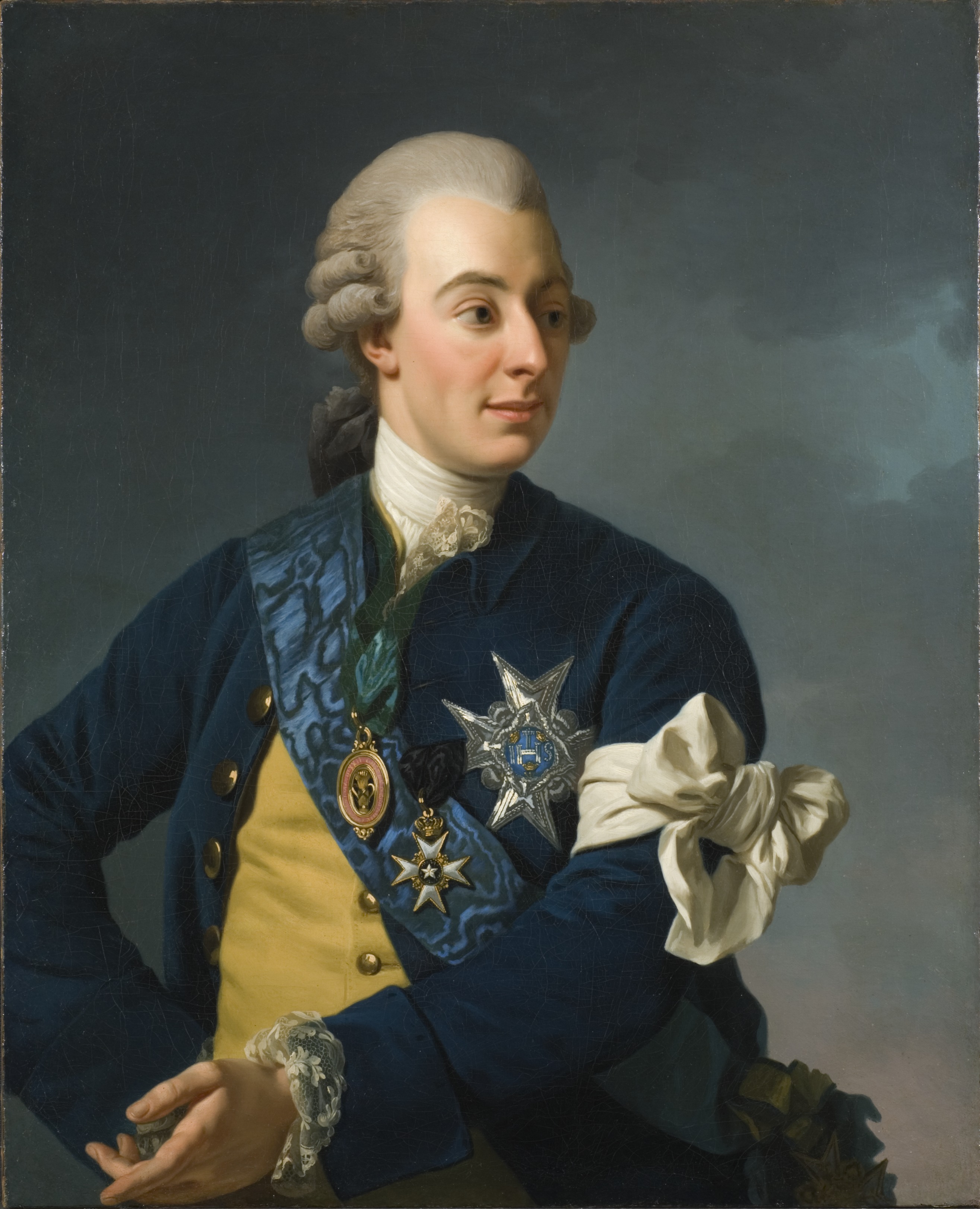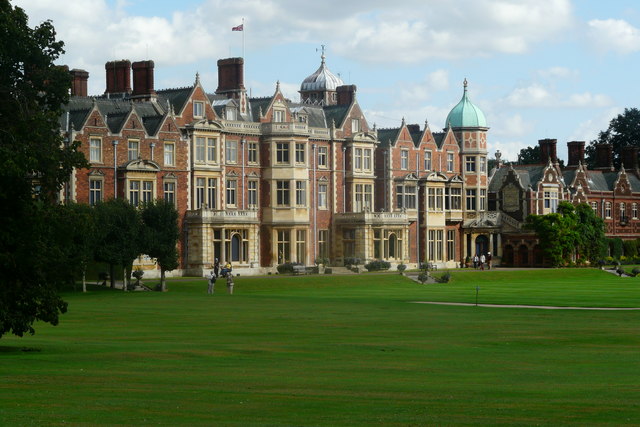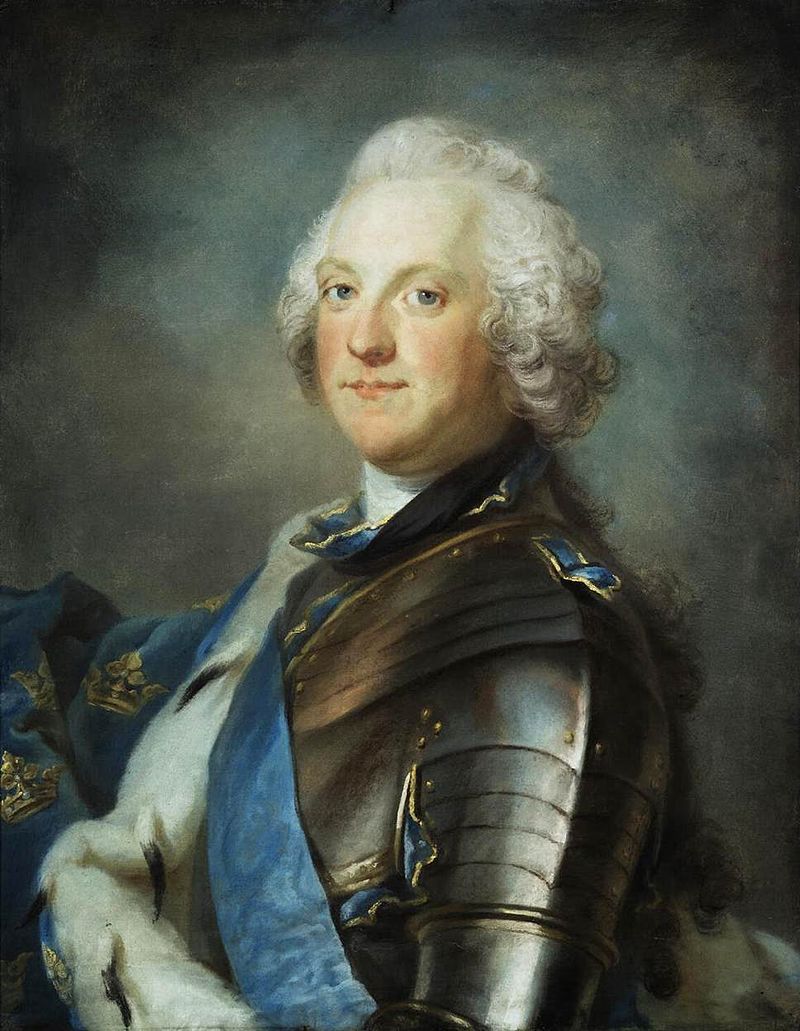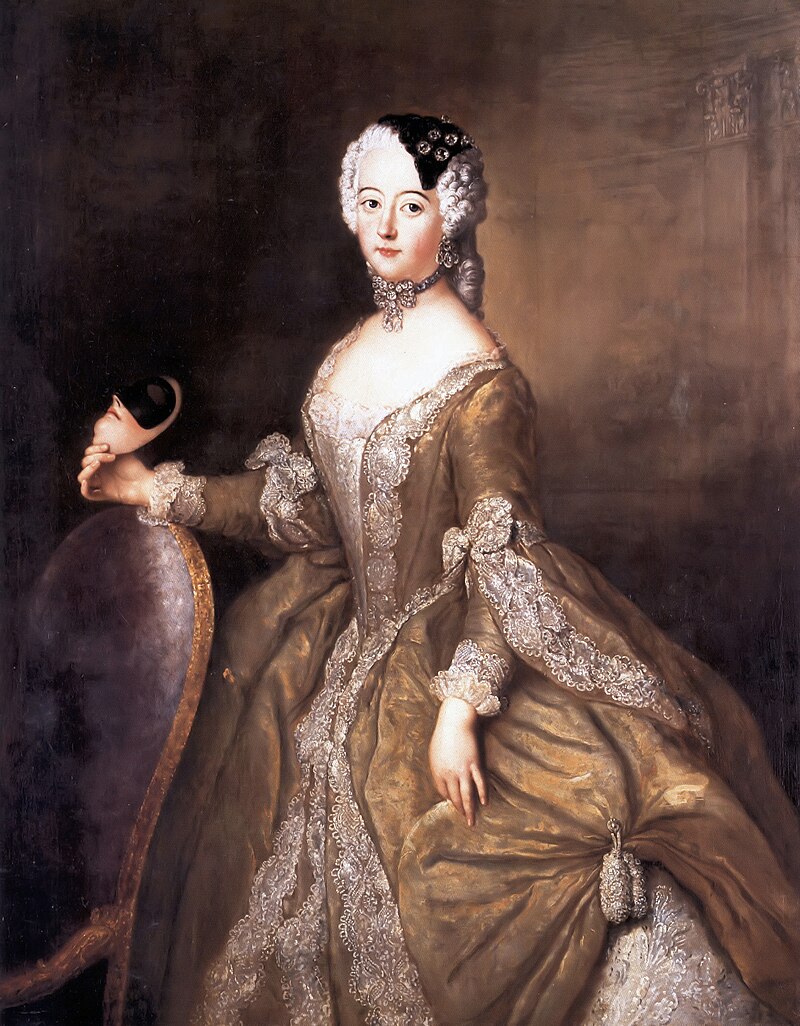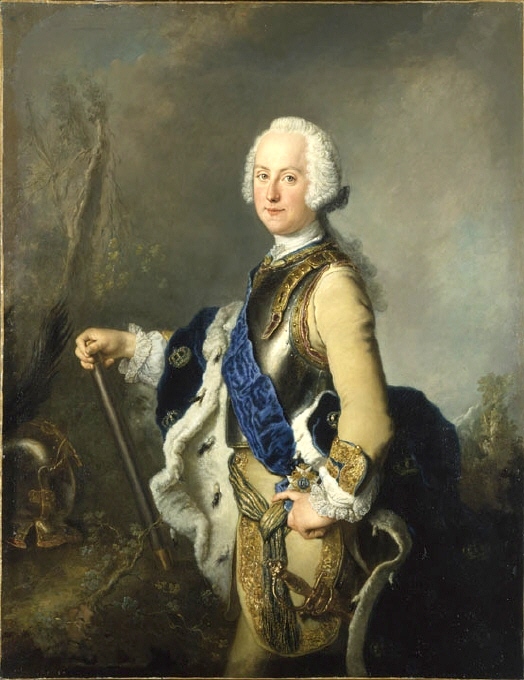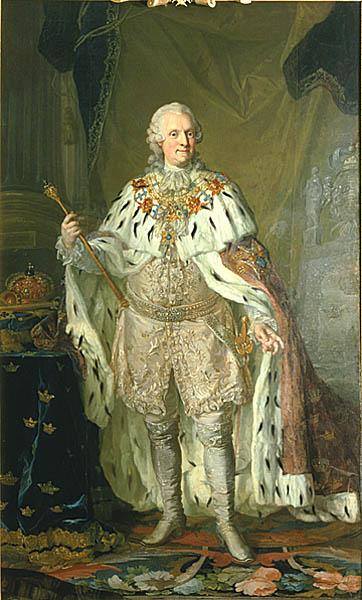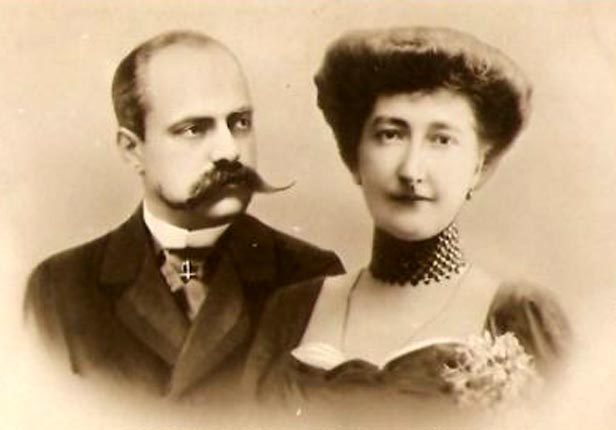by Susan Flantzer
© Unofficial Royalty 2017

King Carl XIII of Sweden/King Karl II of Norway; Credit – Wikipedia
Born the second son of King Adolf Frederik of Sweden and Louisa Ulrika of Prussia, Carl was not destined to be king, but at the age of 60, he became King of Sweden and reigned for nine years. He would be the last Swedish monarch of the House of Holstein-Gottorp. Prince Carl of Sweden was born on October 7, 1748, at the Wrangel Palace on Riddarholmen islet in Gamla Stan, the old town of Stockholm, Sweden. Wrangel Palace was the official Stockholm residence of the Swedish royal family from 1697 until 1754 when the Royal Palace of Stockholm was completed. Carl was the first cousin of Empress Catherine II of Russia (the Great) and the nephew of King Friedrich II of Prussia (the Great).

Prince Carl in 1758; Credit – Wikipedia
Carl had one older brother and a younger brother and sister:
- King Gustav III of Sweden (1746–1792), married Sophia Magdalena of Denmark, had issue
- Frederik Adolf of Sweden, Duke of Östergötland (1750–1803), unmarried
- Sophia Albertine of Sweden, Princess-Abbess of Quedlinburg Abbey, (1753–1829), unmarried

The three sons of King Adolf Frederik: King Gustav III of Sweden, Prince Frederick Adolf, and King Carl XIII of Sweden by Alexander Roslin, 1771; Credit – Wikipedia
During the twenty-year reign of his father King Adolf Fredrik, the King had no real power. The Riksdag (Swedish Parliament) held the power. Adolf Fredrik tried to change this twice, unsuccessfully. Because Carl was second in line to the throne, he was often used as a political tool for the opposition. In 1771, King Adolf Fredrik died and Carl’s brother succeeded to the throne as King Gustav III. In 1772, Gustav arranged for a coup d’état known as the Revolution of 1772 or Coup of Gustav III. The coup d’état reinstated an absolute monarchy and ended parliamentary rule. Gustav imprisoned opposition leaders and established a new regime with extensive power for the king. Carl cooperated with his brother during the coup and as a reward was given the title Duke of Södermanland.
In 1766, King Gustav III married Princess Sophia Magdalena of Denmark. At the time of the coup in 1772, the marriage still had not been consummated and Gustav wanted to give the task of providing an heir to his brother. On July 7, 1774, Carl married his 15-year-old first cousin Princess Hedwig Elisabeth Charlotte of Holstein-Gottorp, daughter of Duke Friedrich August I of Holstein-Gottorp and Princess Ulrike Friederike Wilhelmine of Hesse-Kassel.

Hedwig Elisabeth Charlotte in 1774; Credit – Wikipedia
In July 1775, there were signs that Hedwig Elisabeth Charlotte was pregnant. It was hoped that the succession problem would be solved and prayers were held in the churches. However, there was no pregnancy. The news of the false pregnancy made King Gustav III decide to consummate his marriage and provide an heir to the throne himself and the future King Gustav IV Adolf was born in 1778.
Their marriage was distant and both Carl and his wife had extramarital affairs. Carl and Hedwig Elisabeth Charlotte eventually had two children – one stillborn and one who lived only six days.
- Lovisa Hedvig (stillborn 1797)
- Carl Adolf, Duke of Värmland (born and died 1798)
In the 1780s, King Gustav III was preoccupied with foreign policy: a growing hatred of Denmark and a desire to conquer Norway. In 1788, he began a war against Russia, the Russo-Swedish War, but had to retreat because of a mutiny in the army. In 1789, he resumed the war with varying success. The war ended in 1790 with the Treaty of Värälä. The war with Russia destroyed Sweden’s economy, and when Gustav decided to attack France, a conspiracy developed.

Carl’s brother King Gustav III, 1792; Credit – Wikipedia
The Russo-Sweden War and the implementation of the Union and Security Act in 1789, which gave the king more power and abolished many of the privileges of the nobility, contributed to the increasing hatred of King Gustav III, which had existed among the nobility since the 1772 coup. In the winter of 1791-1792, a conspiracy was formed within the nobility to kill the king and reform the government.
On March 16, 1792, King Gustav III was shot by Jacob Johan Anckarström during a masked ball at the Royal Opera House in Stockholm. Thirteen days later, on March 29, 1792, King Gustav III died of his wounds at the Royal Palace of Stockholm at the age of 46. His 13-year-old son succeeded him as King Gustav IV Adolf. Prince Carl, Duke of Södermanland, the young king’s uncle, served as regent until 1796. Carl was not willing or not capable of managing state affairs and entrusted the power of government to his confidant Count Gustaf Adolf Reuterholm.
In 1805, King Gustav IV Adolf joined the Third Coalition against Napoleon. His campaign went poorly and the French occupied Swedish Pomerania. In 1807, Russia made peace with France. A year later, Russia invaded Finland, which was ruled by Sweden, attempting to force Gustav Adolf to join Napoleon’s Continental System. In just a few months, almost all of Finland was lost to Russia. In 1809, Sweden surrendered the eastern third of Sweden to Russia, and the autonomous Grand Principality of Finland within the Russian Empire was established.

Carl’s nephew King Gustav IV Adolf, 1809; Credit – Wikipedia
Provoked by the disaster in Finland, a group of noblemen started a coup d’état that deposed King Gustav IV Adolf. On March 13, 1809, a group of conspirators broke into the royal apartments at Gripsholm Castle and imprisoned Gustav Adolf and his family. Prince Carl, Gustav Adolf’s uncle, agreed to form a provisional government, and the Swedish parliament, the Riksdag, approved the coup. Gustav Adolf abdicated on March 29, 1809, thinking his son would become king. However, on May 10, 1809, the Riksdag proclaimed that all members of Gustav Adolf’s family had forfeited their rights to the throne. After accepting a new liberal constitution, Prince Carl was proclaimed King Carl XIII of Sweden on June 6, 1809. In December 1809, King Gustav IV Adolf and his family were sent into exile.
Carl was 60 years old and not in good health. In November 1809, he had a stroke and was not able to participate in the government while he recuperated. Since King Gustav IV Adolf’s descendants had been declared ineligible to succeed to the Swedish throne and Carl was childless, a new heir had to be found. Prince Carl August of Schleswig-Holstein-Sonderburg-Augustenburg, the 41-year-old son of Friedrich Christian I, Duke of Schleswig-Holstein-Sonderburg-Augustenburg and Princess Charlotte of Schleswig-Holstein-Sonderburg-Plön, was chosen to be the Crown Prince of Sweden. The new Crown Prince arrived in Sweden in January 1810, but he died from a stroke on May 28, 1810.
The Swedes had the idea to offer the position of Crown Prince to one of Napoleon’s Marshals. Jean Baptiste Bernadotte, appointed Marshal of France in 1804, was well-liked in Sweden, particularly because of his considerate treatment of Swedish prisoners during the recent war with Denmark. In addition, he was related to Napoleon through his wife Désirée Clary, whose sister Julie Clary was married to Napoleon’s brother Joseph Bonaparte. Désirée had previously been engaged to Napoleon. Bernadotte already had a son Oscar, born in 1799, who could continue the succession. On August 21, 1810, the Swedish Riksdag of the Estates elected Bernadotte as Crown Prince. He arrived in Stockholm in November 1810 and was formally adopted by King Carl XIII, taking the name Carl Johan, and converted from Roman Catholicism to Lutheranism.

Jean Baptiste Bernadotte (King Carl XIV Johan of Sweden) as Crown Prince of Sweden; Credit – Wikipedia
The new Crown Prince quickly took an active role in the Swedish government, particularly in foreign policy. He was actively involved in the events leading up to the Treaty of Kiel in 1814, in which Denmark was forced to cede Norway to Sweden. At first, Norway refused to accept the treaty, and the Crown Prince invaded, quickly suppressing the Norwegian forces. Soon, Norway became united with Sweden at the Convention of Moss. Unlike the previous union with Denmark, this was a personal union under a single sovereign, and Norway remained an independent state with its own constitution. King Carl XIII of Sweden also reigned as King Karl II of Norway.

King Carl III, circa 1816; Credit – Wikipedia
King Carl XIII died on February 5, 1818, at the Royal Palace of Stockholm at the age of 69 and he was buried at Riddarholm Church in Stockholm. Jean Baptiste Bernadotte ascended the throne. His coronation in Sweden took place on May 11, 1818, and he took the name King Carl XIV Johan. In September 1818, he was crowned in Norway, as King Karl III Johan. Thus began the Bernadotte dynasty in Sweden, which continues today.
This article is the intellectual property of Unofficial Royalty and is NOT TO BE COPIED, EDITED, OR POSTED IN ANY FORM ON ANOTHER WEBSITE under any circumstances. It is permissible to use a link that directs to Unofficial Royalty.
Works Cited
- En.wikipedia.org. (2017). Charles XIII of Sweden. [online] Available at: https://en.wikipedia.org/wiki/Charles_XIII_of_Sweden [Accessed 25 Sep. 2017].
- En.wikipedia.org. (2017). Hedvig Elisabeth Charlotte of Holstein-Gottorp. [online] Available at: https://en.wikipedia.org/wiki/Hedwig_Elizabeth_Charlotte_of_Holstein-Gottorp [Accessed 25 Sep. 2017].
- Fr.wikipedia.org. (2017). Charles XIII. [online] Available at: https://fr.wikipedia.org/wiki/Charles_XIII [Accessed 25 Sep. 2017].
- Sv.wikipedia.org. (2017). Karl XIII. [online] Available at: https://sv.wikipedia.org/wiki/Karl_XIII [Accessed 25 Sep. 2017].
- Unofficial Royalty. (2017). King Carl XIV Johan of Sweden (Jean Baptiste Bernadotte). [online] Available at: https://www.unofficialroyalty.com/king-carl-xiv-johan-of-sweden-jean-baptiste-bernadotte/ [Accessed 25 Sep. 2017].















